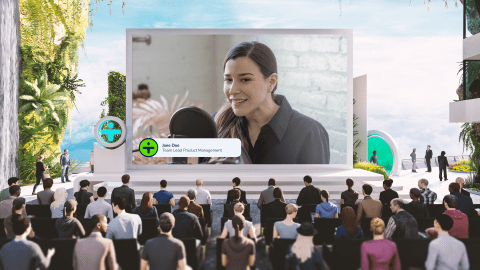
The Evolution Of Non-Physical Events

Tony E. Kula (CEO) / July 2019 / Virtual Event
For humans all over the world, from America to Antarctica and everywhere in between, one fact is always true: We thrive on connection. There’s nothing like sharing experiences with a group of like-minded individuals.
The professional hub for this has traditionally been physical events. The first “tradeshows” can be traced to ancient Middle Eastern bazaars, where merchants would aggressively buy and sell their goods. (Thankfully the events industry has since moved on from bartering on the exhibition floor!)
Physical events have been creating a connection for centuries. But in recent decades, technology has opened a new frontier to engineer that same connection completely remotely: The wonderful world of non-physical events. From intimate live-streamed conferences to huge Hybrid Events, people all around the world can now share the same experience while thousands of miles apart.
I’ve been in the Digital Communication industry for over 25 years. Since beginning my career in the early 1990s, I’ve seen the dominant form of communication shift every decade – from landlines to mobile phones, to the internet. And the 2020s will be no different.
So if you’re a marketer at an international company, how can you capture attention in today’s ever-evolving landscape? Where exactly are we heading? To properly understand where we’re going, we first need to look at where we’ve come from. By understanding the past, we can hope to build the future we want.
Ears, Eyes, And Experiences
Let’s start with a definition: For me, a “non-physical event” is anything that’s bringing people together who are not in the same room. So when did these events begin? With the advent of digital technology in the early 1990s. Before event attendees could “see” each other virtually, they had to “hear” them first. Our first non-physical event medium? Teleconferencing.
At the time Teleconferencing solved a burning problem for marketers: Engaging stakeholders outside of their region at scale. Instead of dialling up people 1 to 1, presenters could speak to groups of dozens or even hundreds over their phones. Customers from diverse backgrounds could all engage with your brand through the same audio experience.
Teleconferencing shows us a trend in digital communication: better technology = bigger audiences at cheaper prices. It used to be unsustainable to engage stakeholders remotely at the same time, and even back then Teleconferencing was a luxury service. Fast forward to today, and we don’t even think twice about dialling into a Zoom conference. As I’ll discuss later, this isn’t the last time we’ll see this big trend play out.
It wasn’t long before audio started influencing physical events too: As attendees explored the exhibition floor, they were given headphones that let them hear information about a certain brand or product, even if they were miles away from the booth itself.
This is a primitive form of an event model we’re seeing rise today: Hybrid Events. Where a physical event is supported digitally so remote attendees can experience a similar event wherever they are in the world.
Back to our History. As technology improved, attendees now had computers that let them live stream events with Video Conferencing. Back in 1997, I ran one of the world’s first video events: Global24. People dialled in from all around the world to see speakers like the President of the European Central Bank discuss their policies. For me, it was a real window into what’s possible when people come together remotely.
The same principle with teleconferencing played out here: non-physical events became even more accessible. As bandwidth improved, so did the capacity to get tech into the hands of the masses. And that’s the big trend that has led us to where we are today. So with that in mind, where exactly are we heading?
The Digital Revolution
As technology improves access, customers can participate in experiences via a wider array of touchpoints than ever before. AR, VR, tablets, headsets, and co. make unforgettable experiences hard to ignore.
And the Hybrid Event model is becoming more of a household name every day. You may have even participated in one yourself without realising it! Consider International Women’s Day: Groups physically meet and march all over the world, but you can also watch live-streamed speeches on their site. Everyone participating feels part of something bigger than themselves.
Marketers also have an opportunity to engage customers through a fresh new marketing channel: Digital Events. This is where an entire exhibition space is created online, and attendees can enjoy an immersive experience from anywhere in the world.
They don’t have the same kind of expense as a physical event, meaning they’re much more sustainable. There’s also less hassle for the participants: They don’t have to deal with traffic, crowds, or waiting in lines. They can “attend” the event from the comfort of their homes, even in their pyjamas! (And yes, digital events are exactly what we do at MEETYOO)
But that’s enough about today. What about tomorrow?
Technology is bringing us closer together than ever before. 20 years ago, the idea of having an entire conference replicated on your computer would have been unthinkable. Now, it’s a very real possibility.
As I said right at the beginning, humans have always thrived on connection. It’s an essential part of who we are. I predict that tomorrow’s successful marketing will keep this front of mind, creating more ways for people to meaningfully connect.
Using technology to be more efficient if it comes at the cost of connection is a bad strategy. Just because you can get in touch with people more quickly doesn’t mean you should. People buy from brands they trust, which means taking real time to connect with your customer is an authentic, engaging way.
Forming a real connection with your customer is often the difference between winning and losing. Whether it’s at a hybrid event, with a video or even just over the phone, treat your non-physical audience with the same respect as if you were in the same room, shaking their hand.
